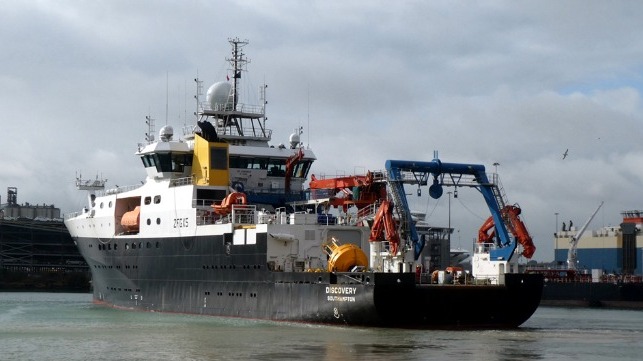Research Ship Sails to Continue Atlantic Ocean Climate Change Study

The National Oceanography Centre’s Royal Research Ship Discovery recently departed Southampton, England continuing a long-term observation as part of a climate change study in the Northeast Atlantic Ocean. According to the team, the research and observations are critical to understanding long-term changes in the oceans.
“This is an exciting expedition that extends a unique observation which the National Oceanography Centre has run for 36-years,” said Dr. Sue Hartman who is leading the expedition. “The new observations and samples that we collect are needed to study the changing Atlantic Ocean and climate regulation and ocean services. The research will assess how the ocean and deep-sea eco-systems will evolve as a result of climate change and intensified human exploitation.”
The science and technical teams onboard the Discovery departed on March 25 to carry out a range of water column and seafloor sampling data collection operations as part of the Porcupine Abyssal Plain Sustained Observatory. As part of the project, which started in 1985, they will continue the long-term measurements of sedimentation events and water currents within the Whittard Canyon, a major submarine canyon system within a geological feature that hosts England’s only deep-sea marine protected area.
The team will also service a UK Met Office buoy that monitors Atlantic weather for wind speed and direction, relative humidity, air and sea temperatures, atmospheric pressure, sunlight, atmospheric CO2, wave height, and period. This five-kilometer-deep ocean mooring is also equipped with National Oceanography Centre’s oceanographic sensors that test for salinity, temperature, CO2, O2, ocean acidity, phytoplankton pigments, nutrients, and sunlight. These measurements will be used to study natural variability in the ocean.
A second mooring in the study carries a series of sediment traps that monitor seasonal variations in the sinking particles that carry carbon from the surface ocean to the deep-sea floor. The oceanic uptake of CO2 reduces atmospheric levels of this greenhouse gas. Following this carbon, from the surface to ocean depths, will show how much carbon is locked away under the sea.
In addition to extensive water column and seafloor sediment sampling, the team will use a marine autonomous robotic vehicle to video and photograph the seafloor. The vehicle will document the presence of the particulate organic matter and larger wildlife that it feeds, such as sea cucumbers and sea anemones.
The National Oceanography Centre, the UK’s institution for integrated coastal and deep ocean research, undertakes and facilitates scientific research and technology development to understand the global ocean. They operate two royal research ships, the James Cook and the Discovery, and develop technology for coastal and deep ocean research.
